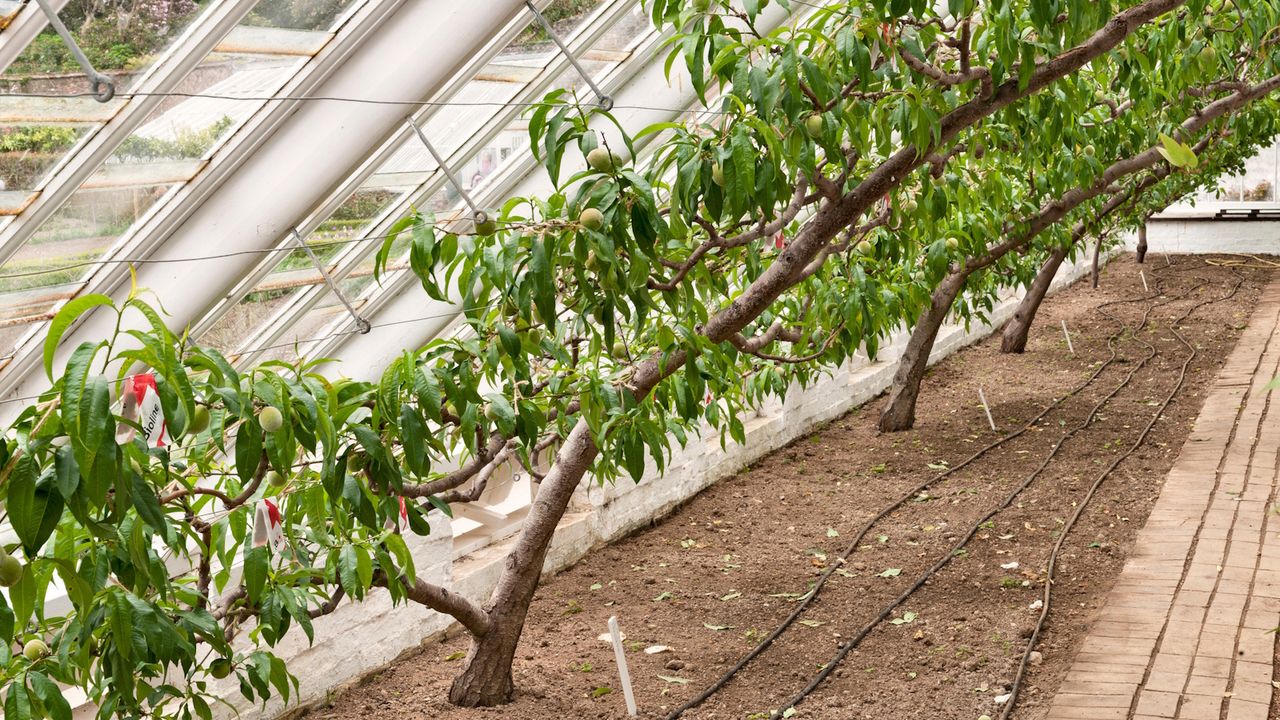Top Stories
Victorian Glasshouse Revolutionizes Peach Harvests in Wet Climates

UPDATE: A Victorian glasshouse technique is transforming peach harvesting in cold, wet climates, allowing growers to enjoy bountiful yields year after year. Just announced by experts at Gravetye Manor in Sussex, England, this historic method protects peach trees from devastating diseases and frost damage, making homegrown peaches a reality for many.
For those dreaming of juicy peaches in rain-soaked regions, this innovative approach may hold the key. Tom Coward, Head Gardener at Gravetye Manor, revealed that the estate has successfully cultivated peach trees since 1884, when renowned horticulturist William Robinson began his groundbreaking work there.
Coward explained that the use of a glasshouse is critical in preventing peach leaf curl, a fungal disease exacerbated by heavy rainfall. This condition can devastate fruit production, causing leaves to distort and weaken trees. The Victorian glasshouse provides a controlled environment, safeguarding peaches from moisture-related issues.
“We plant peach trees out of tradition,” Coward stated during a recent visit. “By putting them under glass, you don’t get peach leaf curl. You get high-quality fruit early in the season, and you can keep the squirrels away.” This innovative technique ensures that blossoms are shielded from frost, a common threat to fruiting.
The glasshouse at Gravetye Manor dates back to the time of Robinson but underwent a significant restoration in 2012. This structure has allowed the estate to flourish, yielding varieties like ‘Amsden June’ and ‘Red Haven’ each summer.
In the United States, peach trees face similar challenges, particularly in hardiness zones 6 to 8. Areas prone to excess moisture can struggle with disease, but Coward’s methods offer hope to gardeners everywhere. The concept of utilizing glasshouses surged during the Victorian era due to advancements in technology and materials, enabling more gardeners to embrace this practice.
For those without access to a full glasshouse, Coward suggested alternatives for home gardeners. Compact peach trees can thrive in smaller greenhouses or even in pots. Proper soil drainage is essential to avoid waterlogged conditions, which can lead to diseases.
To successfully grow peaches in a greenhouse, Coward advised ventilating the space to prevent overheating and fungal issues. “Training your trees for better airflow is key,” he noted, recommending techniques like oblique cordon training or espalier methods against walls.
The excitement surrounding this Victorian horticultural method is palpable, especially as summer approaches. Peach harvests typically occur during this season, with the best fruits turning yellow, blushing, and yielding slightly to pressure.
As the world looks for sustainable solutions in food production amidst climate challenges, the Victorian glasshouse technique stands out as a beacon of innovation. With Gravetye Manor leading the way, home gardeners may soon find themselves harvesting delicious peaches, regardless of their local climate conditions.
Stay tuned for more updates on peach cultivation techniques and the ongoing impact of historical gardening practices on modern agriculture.
-

 Science5 days ago
Science5 days agoInventor Achieves Breakthrough with 2 Billion FPS Laser Video
-

 Top Stories1 week ago
Top Stories1 week agoCharlie Sheen’s New Romance: ‘Glowing’ with Younger Partner
-

 Entertainment1 week ago
Entertainment1 week agoDua Lipa Aces GCSE Spanish, Sparks Super Bowl Buzz with Fans
-

 Business1 week ago
Business1 week agoTyler Technologies Set to Reveal Q3 Earnings on October 22
-

 World1 week ago
World1 week agoR&B Icon D’Angelo Dies at 51, Leaving Lasting Legacy
-

 Entertainment1 week ago
Entertainment1 week agoMother Fights to Reunite with Children After Kidnapping in New Drama
-

 Health1 week ago
Health1 week agoCurium Group, PeptiDream, and PDRadiopharma Launch Key Cancer Trial
-

 Science1 week ago
Science1 week agoNorth Carolina’s Biotech Boom: Billions Invested in Manufacturing
-

 Health1 week ago
Health1 week agoCommunity Unites for 7th Annual Into the Light Walk for Mental Health
-

 Entertainment1 week ago
Entertainment1 week agoRed Sox’s Bregman to Become Free Agent; Tigers Commit to Skubal
-

 Health1 week ago
Health1 week agoNorth Carolina’s Biotech Boom: Billions in New Investments
-

 Top Stories1 week ago
Top Stories1 week agoDisney+ Launches Chilling Classic ‘Something Wicked’ Just in Time for October









